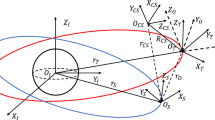Abstract
ASTER, the first Brazilian mission to the deep space, targets the exploration of the triple asteroid system known as 2001 SN263. The mission requires an attitude controller robust and capable of coping with the non-linearities and the uncertainties present during the exploration phase. For such requirements, this paper studies the applicability of two controllers, designed based on the sliding mode control (SMC) technique, one of the controllers include an adaptive law used to compensate for the spacecraft’s inertia variation. One application is performed where gain scheduling is used for controlling two different phases: exit from tumbling and track a dynamic reference. The actuators of the attitude control loops are impulsive thrusters. They are activated by pulse width modulation (PWM) or pulse width pulse frequency modulation (PWPFM). Simulation studies, performed in realistic scenarios, show that the SMC can maintain stability and performance when these modulation techniques are used to approximate the continuous commands. It is also shown that PWM can provide better performance, but at a higher control cost. In this sense, PWPFM is more appropriate with respect to the fuel consumption and activation times.


















Similar content being viewed by others
References
Fang J, Margot JL, Brozovic M, Nolan MC, Benner LAM, Taylor PA (2011) Orbits of near-earth asteroid triples 2001 sn263 and 1994 cc: Properties, origin, and evolution. Astronom J 141(5). doi:10.1088/0004-6256/141/5/154
Hung JY, Gao W, Hung JC (1993) Variable structure control: a survey. IEEE Trans Ind Electron 40(1):2–22. doi:10.1109/41.184817
Macau EE, Winter O, de Campos Velho HF (2011) The aster mission: exploring for the first time a triple system asteroid. In: 62nd International Astronautical Congress. Curran Associates Inc, Cape Town, pp 3669–3677
Murray CD, Dermott SF (2000) Solar system dynamics. Cambridge University Press, Cambridge
Qingleia H, Youminb Z, Xinga H, Binga X (2011) Adaptive integral-type sliding mode control for spacecraft attitude maneuvering under actuator stuck failures. Chin J Aeronaut 24(1):32–45. doi:10.1016/S1000-9361(11)60005-8
Sarli B, da Silva AL, Paglione P (2013) Preliminary attitude control studies for the aster mission. J Phys: Conf Ser 465(1). doi:10.1088/1742-6596/465/1/012004
Sarli B, Winter O, Paglione P, Neto EV (2012) Strategies for exploring the triple system 2001sn263—target of the aster mission. In: 39th COSPAR scientific assembly, Mysore, India, p 1680
Sidi MJ (1997) Spacecraft dynamics and control: a practical engineering approach, chap. 9. Cambridge University Press, New York
da Silva AL, Vargas FJT, Paglione P (2008) A procedure to design aircraft flight control laws taking into account robustness using the variable structure control. In: 26th International Congress of the aeronautical sciences. Anchorage, Alaska
Slotine JJ, Li W (1991) Applied nonlinear control. Prentice Hall, London
Utkin VI (1977) Variable structure system with sliding modes. IEEE Trans Autom Control 22(2):212–222. doi:10.1109/TAC.1977.1101446
Wytrzyszczak I, Breiter S, Borczyk W (2007) Regular and chaotic motion of high altitude satellites. Adv Space Res 40(1):134–142. doi:10.1016/j.asr.2006.11.020
Yeh FK (2010) Sliding-mode adaptive attitude controller design for spacecrafts with thrusters. IET Control Theory Appl 4(7):1254–1264. doi:10.1049/iet-cta.2009.0026
Author information
Authors and Affiliations
Corresponding author
Additional information
Communicated by Elbert Macau and Cristiano Fiorilo.
Rights and permissions
About this article
Cite this article
Sarli, B.V., da Silva, A.L. & Paglione, P. Sliding mode attitude control using thrusters and pulse modulation for the ASTER mission. Comp. Appl. Math. 34, 535–556 (2015). https://doi.org/10.1007/s40314-014-0146-7
Received:
Revised:
Accepted:
Published:
Issue Date:
DOI: https://doi.org/10.1007/s40314-014-0146-7




